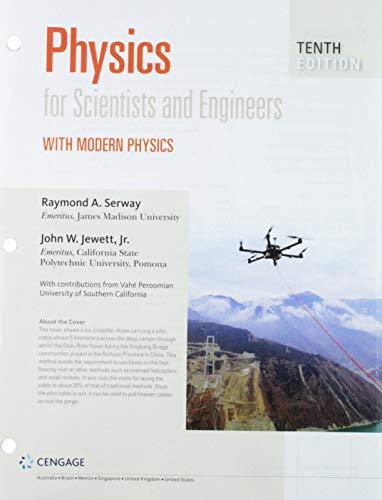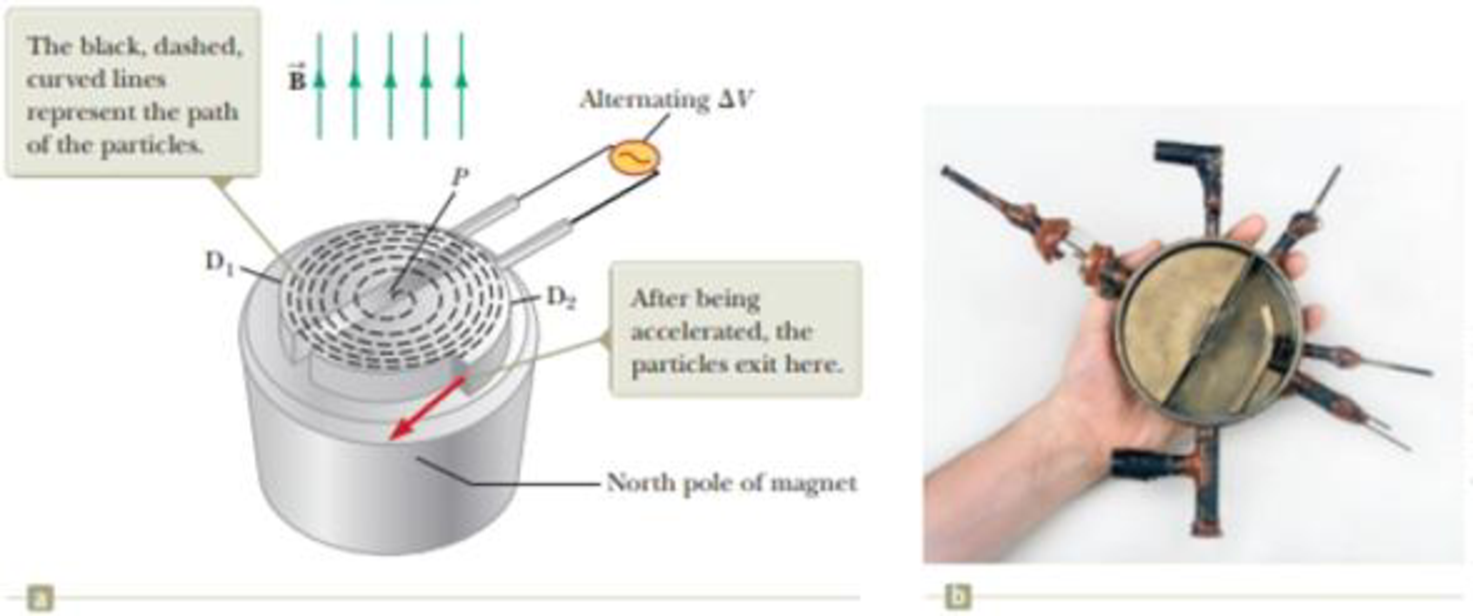
Concept explainers
A particle in the cyclotron shown in Figure 28.16a gains energy qΔV from the alternating power supply each time it passes from one dee to the other. The time interval for each full orbit is
so the particle’s average rate of increase in energy’ is
Notice that this power input is constant in time. On the other hand, the rate of increase in the radius r of its path is not constant. (a) Show that the rate of increase in the radius r of the panicle’s path is given by
(b) Describe how the path of the particles in Figure 28.16a is consistent with the result of part (a). (c) At what rate is the radial position of the protons in a cyclotron increasing immediately before the protons leave the cyclotron? Assume the cyclotron has an outer radius of 0.350 m, an accelerating voltage of ΔV = 600 V, and a magnetic field of magnitude 0.800 T. (d) By how much does the radius of the protons’ path increase during their last full revolution?
Figure 28.16 (a) A cyclotron consists of an ion source at P, two does D1 and D2 across which an alternating potential difference is applied, and a uniform magnetic field. (The south pole of the magnet is not shown.) (b) The first cyclotron, invented by E. O. Lawrence and M. S. Livingston in 1934.

(a)
To prove: The rate of increase in the radius
Answer to Problem 18P
The rate of increase in the radius
Explanation of Solution
Given Info: The time interval of full orbit is
The formula for the energy is,
Here,
Differentiating equation (1) with respect to time
The above equation can be rewritten as,
Substitute
The formula for the centripetal force is,
The above equation can be rewritten as,
Differentiating equation (3) with respect to time
Deducing from equation (2) and equation (4),
Conclusion:
Therefore, the rate of increase in the radius
(b)
The path of the particle is consistent.
Answer to Problem 18P
The path of the particle is consistent.
Explanation of Solution
Given Info: The time interval of full orbit is
The formula of change of radius with time is,
The value of the path of the particle is consistent with respect to time as according to the above formula the path is dependent on the radius of circle and the magnitude of the magnetic field which remains constant for a path.
Thus, the path of the particle is consistent.
Conclusion:
Therefore, the path of the particle is consistent.
(c)
The rate of increase of the radial direction of proton.
Answer to Problem 18P
The rate of increase of the radial direction of proton. is
Explanation of Solution
Given Info: The time interval of full orbit is
The formula for the change of radius with time is,
Substitute
Thus, the rate of increase of the radial direction of proton is
Conclusion:
Therefore, the rate of increase of the radial direction of proton is
(d)
The increase in the radius of the path of proton.
Answer to Problem 18P
The increase in the radius of the path of proton is
Explanation of Solution
Given Info: The time interval of full orbit is
The formula for the velocity is,
Substitute
Thus, the velocity of proton is
The formula for the energy is,
Substitute
The formula for the energy at the end is,
Substitute
The formula for the radius at the end is,
Substitute
The formula for the increase in the radius is,
Substitute
Thus the increase in the radius of the path of proton is
Conclusion:
Therefore, increase in the radius of the path of proton is
Want to see more full solutions like this?
Chapter 28 Solutions
Bundle: Physics For Scientists And Engineers With Modern Physics, Loose-leaf Version, 10th + Webassign Printed Access Card For Serway/jewett's Physics For Scientists And Engineers, 10th, Single-term
Additional Science Textbook Solutions
Fundamentals Of Thermodynamics
General, Organic, and Biological Chemistry: Structures of Life (5th Edition)
Campbell Biology (11th Edition)
Human Biology: Concepts and Current Issues (8th Edition)
Human Physiology: An Integrated Approach (8th Edition)
- Lab Assignment #3 Vectors 2. Determine the magnitude and sense of the forces in cables A and B. 30° 30° 300KN 3. Determine the forces in members A and B of the following structure. 30° B 200kN Name: TA: 4. Determine the resultant of the three coplanar forces using vectors. F₁ =500N, F₂-800N, F, 900N, 0,-30°, 62-50° 30° 50° F₁ = 500N = 900N F₂ = 800Narrow_forwardLab Assignment #3 Vectors Name: TA: 1. With the equipment provided in the lab, determine the magnitude of vector A so the system is in static equilibrium. Perform the experiment as per the figure below and compare the calculated values with the numbers from the spring scale that corresponds to vector A. A Case 1: Vector B 40g Vector C 20g 0 = 30° Vector A = ? Case 2: Vector B 50g Vector C = 40g 0 = 53° Vector A ? Case 3: Vector B 50g Vector C 30g 0 = 37° Vector A = ?arrow_forwardThree point-like charges are placed at the corners of an equilateral triangle as shown in the figure. Each side of the triangle has a length of 20.0 cm, and the point (A) is located half way between q1 and q2 along the side. Find the magnitude of the electric field at point (A). Let q1=-1.30 µC, q2=-4.20µC, and q3= +4.30 µC. __________________ N/Carrow_forward
- Find the total capacitance in micro farads of the combination of capacitors shown in the figure below. 2.01 0.30 µF 2.5 µF 10 μF × HFarrow_forwardI do not understand the process to answer the second part of question b. Please help me understand how to get there!arrow_forwardRank the six combinations of electric charges on the basis of the electric force acting on 91. Define forces pointing to the right as positive and forces pointing to the left as negative. Rank in increasing order by placing the most negative on the left and the most positive on the right. To rank items as equivalent, overlap them. ▸ View Available Hint(s) [most negative 91 = +1nC 92 = +1nC 91 = -1nC 93 = +1nC 92- +1nC 93 = +1nC -1nC 92- -1nC 93- -1nC 91= +1nC 92 = +1nC 93=-1nC 91 +1nC 92=-1nC 93=-1nC 91 = +1nC 2 = −1nC 93 = +1nC The correct ranking cannot be determined. Reset Help most positivearrow_forward

 Glencoe Physics: Principles and Problems, Student...PhysicsISBN:9780078807213Author:Paul W. ZitzewitzPublisher:Glencoe/McGraw-Hill
Glencoe Physics: Principles and Problems, Student...PhysicsISBN:9780078807213Author:Paul W. ZitzewitzPublisher:Glencoe/McGraw-Hill Principles of Physics: A Calculus-Based TextPhysicsISBN:9781133104261Author:Raymond A. Serway, John W. JewettPublisher:Cengage Learning
Principles of Physics: A Calculus-Based TextPhysicsISBN:9781133104261Author:Raymond A. Serway, John W. JewettPublisher:Cengage Learning Physics for Scientists and Engineers with Modern ...PhysicsISBN:9781337553292Author:Raymond A. Serway, John W. JewettPublisher:Cengage Learning
Physics for Scientists and Engineers with Modern ...PhysicsISBN:9781337553292Author:Raymond A. Serway, John W. JewettPublisher:Cengage Learning Physics for Scientists and EngineersPhysicsISBN:9781337553278Author:Raymond A. Serway, John W. JewettPublisher:Cengage Learning
Physics for Scientists and EngineersPhysicsISBN:9781337553278Author:Raymond A. Serway, John W. JewettPublisher:Cengage Learning Modern PhysicsPhysicsISBN:9781111794378Author:Raymond A. Serway, Clement J. Moses, Curt A. MoyerPublisher:Cengage Learning
Modern PhysicsPhysicsISBN:9781111794378Author:Raymond A. Serway, Clement J. Moses, Curt A. MoyerPublisher:Cengage Learning





